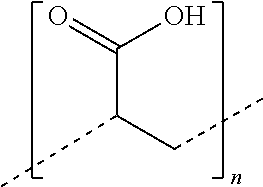Soy composite materials comprising an amino resin and methods of making the same
a technology of amino resins and composite materials, which is applied in the field of composite materials and methods of making the same, can solve the problems of poor application during wet-laid mat formation, low binder weight (loi), and production of tracks, streaks, and low soy flour solubility, soy flour solubility, and soy flour solubility. the effect of reducing the viscosity
- Summary
- Abstract
- Description
- Claims
- Application Information
AI Technical Summary
Benefits of technology
Problems solved by technology
Method used
Image
Examples
examples 1-6
[0096]A 5-liter round-bottom flask equipped with a paddle stirrer, thermocouple, nitrogen inlet, and reflux condenser was charged with 876.4 grams of deionized water, 24.2 grams of sodium hypophosphite monohydrate, 28.5 grams of a sodium lauryl ether sulfate surfactant solution (30%), 3.1 grams of sodium hydroxide, and 0.058 grams of an inhibitor. The mixture was heated to 79° C.
[0097]For Example 1, a monomer emulsion was prepared using 459.7 grams of deionized water, 89.2 grams of a sodium lauryl ether sulfate surfactant solution (30%), 553.9 grams of butyl acrylate, 969.7 grams of styrene, and 268.9 grams of acrylic acid. A 97.0 gram aliquot of this monomer emulsion was added to the reaction flask, with stirring, followed by a solution of 7.4 grams of ammonium persulfate dissolved in 33.3 grams of deionized water. After an exotherm and while maintaining a reaction temperature of 85° C., the monomer emulsion and a separate solution of 7.4 grams of ammoni...
example 7
[0100]A 2-liter, four necked round bottom flask, equipped with a condenser, thermocouple and overhead stirring, was loaded with a mixture of 405.0 g of deionized water, 105.0 g of acrylic latex of particle diameter 58 nm and 3.0 g of ammonium persulfate at 85° C. A monomer emulsion was prepared using 125.0 grams of deionized water, 20.0 grams of a sodium lauryl ether sulfate surfactant solution (30%), 258.0 grams of butyl acrylate, 282.0 grams of methyl methacrylate, and 60.0 grams of acrylic acid. With the initial charge stirring at 85° C. the monomer emulsion and a solution of 3.0 g of ammonium persulfate in 66.0 g of deionized water were gradually added to the reaction flask over 120 minutes while maintaining the temperature at 85-87° C. After the addition of the monomer emulsion and ammonium persulfate solution was complete the reaction mixture was held at 85° C. for 15 minutes. The reaction flask was then cooled to 70° C. A solution of 1.40 g of 0.15...
example 8
Preparation of Aqueous Admixture of Urea Formaldehyde (UF) Resin and Latex Emulsion Polymer
[0101]The comparative Sample 23, in Table 2 and 3 below, is an aqueous admixture of UF resin FG-472× as a majority component and a latex emulsion copolymer Polymer B (Table 2), as follows: an aqueous admixture with a UF / latex blend weight ratio of 9:1, at 20% solids, i.e. 9 weight parts UF resin solids per 1 part latex solids in 40 parts of water, is prepared.
[0102]In Table 2 and 3 below, comparative binders Samples 2-4 comprise UF resin alone (SU-100 or FG-472X, from Hexion Specialty Chemicals, Columbus, Ohio, USA). These control samples demonstrate the properties of the UF resin without any latex polymer modifier.
PUM
| Property | Measurement | Unit |
|---|---|---|
| particle size | aaaaa | aaaaa |
| wt. % | aaaaa | aaaaa |
| temperature | aaaaa | aaaaa |
Abstract
Description
Claims
Application Information
 Login to View More
Login to View More - R&D
- Intellectual Property
- Life Sciences
- Materials
- Tech Scout
- Unparalleled Data Quality
- Higher Quality Content
- 60% Fewer Hallucinations
Browse by: Latest US Patents, China's latest patents, Technical Efficacy Thesaurus, Application Domain, Technology Topic, Popular Technical Reports.
© 2025 PatSnap. All rights reserved.Legal|Privacy policy|Modern Slavery Act Transparency Statement|Sitemap|About US| Contact US: help@patsnap.com

